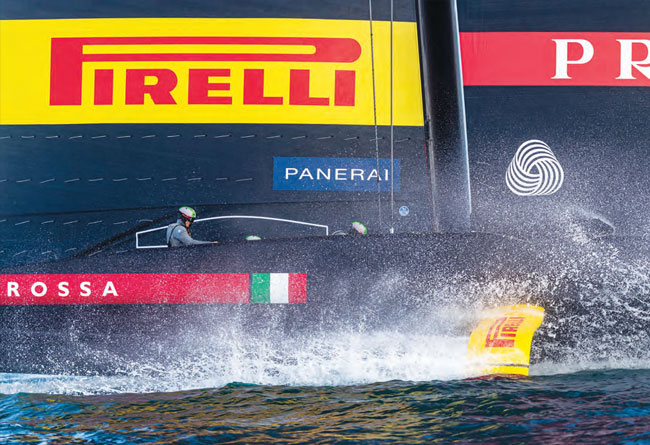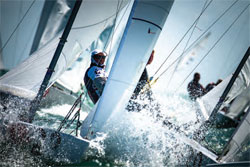

Minimising sun damage when sailing has long been a major concern for sailors but a casual conversation with America’s Cup winner Jimmy Spithill highlighted the second part of the equation for dermatologist Edit Harken
It was a beautiful breezy September morning in 2014 during the famous (or infamous) E-scow Blue Chip invitational regatta when I finally decided to start a skin care line for sailors. As a tradition, my husband Peter (Harken) and I hosted the mystery guest at our house every year. Pewaukee Yacht Club has always invited sailors that had an outstanding accomplishment the previous year and although it wasn’t the Rolex World Sailor of the Year Award, Peter, Olaf (Harken) and the rest of the yacht club gang somehow always managed to convince the sailors that competing in an E-scow invitational with the best of the inland sailors may just be the biggest honour and challenge of their life.
‘That morning I served breakfast to Jimmy Spithill, who, the previous year, had won the America’s Cup in the ‘biggest comeback of sport history’. I have had talks with him in the past about his white freckly skin and helped him out on occasions. Jimmy grew up in Australia on the water as a red head, so he certainly was aware of the importance of sun protection and was very good at using sunscreen. As I have been regularly asked for my advice about sunscreens in the past, Jimmy’s question took me by surprise. He wasn’t asking about sunscreens, instead, he wanted my opinion about what to use to repair his skin after a long day of sailing. He, the consummate professional, wanted professional advice on how to mitigate the damage and keep his skin from aging as quickly as all his older mates’ skin.
I had been thinking about creating a sunscreen for sailors for a while, but this was my eureka moment and the inspiration for a comprehensive ‘two-step solution’ that not only includes a professional grade allmineral sunscreen, but also has an after-sun antioxidant barrier repair moisturizer. As I regularly explain to my patients, sunscreen is the first line of defence and the antioxidants are the warriors of second line defense. These two products are designed to complement each other to achieve the maximal cancer prevention and anti-aging efficacy. I realised that sailors don’t have time to see a dermatologist unless unfortunately they are forced to, due to skin cancer. They don’t have time to read, ask or get advice although they need it the most. The triple threat of wind, water and sun wreaks havoc on their skin due to those elements causing DNA, oxidative and skin barrier damage and repeated, cumulative exposure puts them at a very high risk not just for skin cancer, but for accelerated aging too. Sailors’ skin needs strong sun protection, antioxidant defence and skin barrier repair as well as strong anti-aging, collagen stimulatory help.
I felt sailors were not the type that would want to use many different products, and therefore I needed to put all the necessary, but still appropriate ingredients, together in a high potency formulation. As I explained to Jimmy that morning, there was a trick about anti-aging products for sailors; dermatologists adore vitamin A-type ingredients (retinol, retinoic acid) for their strong anti-aging effects, however those ingredients also increase the risk for sunburn. Therefore, I would always recommend them with caution to professional sailors and preferred other ingredients that are safe for use in the sun.
When I’m asked, I always credit Jimmy and his question for the final motivation for launching not just a super-sunscreen, but another antioxidant, hydrating barrier repair product as well, that in my mind was perfectly tailored to people who are on the water and exposed to the sun for extended time. I was frustrated with going through the basket of sunscreens on boats we were invited to sail on and finding most of them expired or useless. On a typical daysail, whether it was a maxi or a small boat, by the end of the day I found myself giving advice to both men and women on the boat about sunscreens and other matters of skin care. I had my list of favourite sunscreens and they were my favourites for good reason. Cutaneous photobiology, or in other words, the interaction of light with human skin, was always one of my major interests and I have done research in that field. I talk about, recommend and explain sunscreens to my patients every day. Sunscreens and various ways of cancer prevention were always a passion of mine.
I did my homework and asked many sailors what they liked and disliked in sunscreens. I was told it couldn’t be thin and runny as it would drip on the boat and make the deck and their hands slippery. It couldn’t be greasy for the same reasons. It had to be very water and sweat resistant and of course could not run into and burn the eyes. No scent of vanilla and coconut, perhaps rum. Oh yes and please make one that lasts all day.

Above: a conversation with two-time Americaʼs Cup winner Jimmy Spithill was the eureka moment for dermatologist Edit Harken. She realised that not only did sailors need a very effective sunscreen, they also needed an equally strong antioxidant, hydrating barrier repair product to combat the premature aging of their skin.
Below: small boat sailors are especially vulnerable to skin damage as thereʼs nowhere to shelter from the sun

Back when I started, problems with the absorption of chemical UV filters by corals and humans were not in the press, nor on people’s minds. But I knew about those issues and decided to formulate a sunscreen that only had mineral filters. That turned out to be quite difficult. All the cosmetic chemists who I talked to in the process of formulation wanted to convince me to use zinc oxide and add chemical filters to it for several reasons; it was easier and cheaper to formulate and produced a more transparent sunscreen that led to more cosmetic elegance. Zinc oxide and titanium dioxide are non-soluble filters and their formulation is difficult and costly especially for high SPF and very water-resistant preparations. That’s the reason that lots of the lighter, lotion-type sunscreen bottles with only mineral filters contain a tiny ball and need to be shaken before use to resuspend the floating zinc oxide particles. If they are not shaken well, the sunscreen’s efficiency is drastically reduced. I am proud Harken Derm sunscreen has everything that the sailors asked for and I set out to do; it has no chemical filters and therefore it is safe for both reefs and humans. It has very high UVB and UVA protection (SPF50, the highest rating allowed in the US) and it’s very water resistant – so much so that it does last all day without running into the eyes. It has added antioxidants that serve a second line of defense by reducing free radical damage. I often say this is not a sunscreen created for the guys on Wall Street, it is for athletes out in the elements all day. And when I am told it is difficult to wash Harken Derm off at the end of the day, my answer is; ‘good, that means it kept you covered in the toughest conditions’. That became our motto written on our sunscreen tubes.
Originally, I wanted to name the products ‘Harken Block’. I thought it would have been cheeky and fun. Unfortunately, I was advised against it by my friends in the regulatory business. They warned that if our company becomes ‘big’, somebody may alert the FDA as the name ‘sunblock’ is not permitted in the labeling regulations due to its misleading meaning. Nothing blocks the sun out completely, even SPF50 although it screens about 98.5% of UVB rays, it allows about 1.5% through and even more UVA rays if the filters are not broad spectrum (SPF only measures UVB protection).
At the end, the name of Harken Derm was born from a marriage of a man, Peter Harken, with a trusted name in the sailing industry and a practicing dermatologist – me, with a research background and expertise in the skin cancer prevention and aesthetic fields. As an academic dermatologist, my passion is in educating, giving advice and treating my patients and now in helping sailors. I realise that there are many choices out there for sunscreens and skin care products. My aspiration with Harken Derm was to make it easier for sailors to decide what’s best to protect and keep their skin healthy in the toughest conditions.
Click here for more information on Harken Derm »
We invite you to read on and find out for yourself why Seahorse is the most highly-rated source in the world for anyone who is serious about their racing.
To read on simply SIGN up NOW
Take advantage of our very best subscription offer or order a single copy of this issue of Seahorse.
Online at:
www.seahorse.co.uk/shop and use the code TECH20
Or for iPad simply download the Seahorse App at the iTunes store


